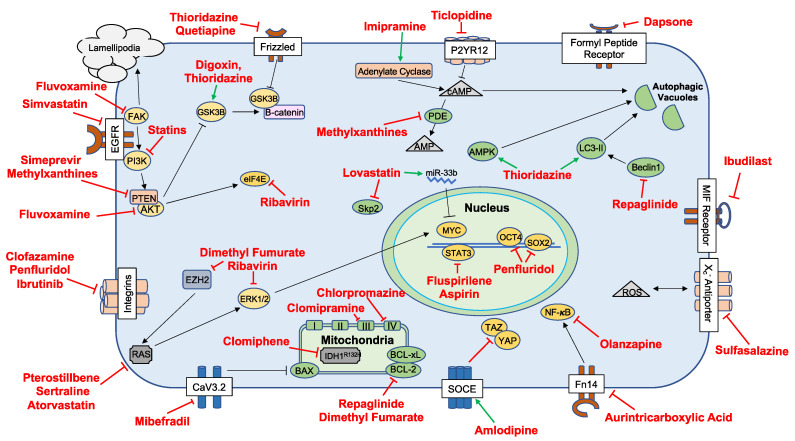Figure 1.
Cellular pathways and interactions detailing the key proposed mechanisms of drugs that have completed preclinical investigation and have yet to be fully studied in the clinical setting. Abbreviations: Adenosine diphosphate receptor (P2YR12); cyclic adenosine 3′,5′-cyclic monophosphate (cAMP); adenosine 3′,5′-cyclic monophosphate (AMP); phosphodiesterase (PDE); glycogen synthase kinase (GSK3B); phosphoinositide 3-kinase (PI3K); AMP-activated protein kinase (AMPK); microtubule-associated protein 1A/1B-light chain 3 phosphatidylethanolamine conjugate (LC3-II); signal transducer and activator of transcription 3 (STAT3); (sex determining region Y)-box 2 (SOX2); octamer-binding transcription factor 4 (OCT4); focal adhesion kinase (FAK); phosphatase and tensin homolog (PTEN); protein kinase B (AKT); eukaryotic translation initiation factor (eIF4e); S-phase kinase-associated protein 2 (Skp2); microRNA-33b (miRNA-33b); Macrophage migration inhibitory factor (MIF); reactive oxygen species (ROS); tafazzin (TAZ); yes associated protein (YAP); fibroblast growth factor-inducible 14 (Fn14); store-operated calcium entry (SOCE); isocitrate dehydrogenase 1 (IDH1); enhancer of zeste homolog 2 (EZH2); rat sarcoma (RAS); extracellular signal-regulated kinase (ERK); epidermal growth factor receptor (EGFR); t-type calcium channel (CaV3.2); Bcl-2-associated X protein (BAX); B-cell lymphoma 2 (BCL2); B-cell lymphoma-xL (BCL-XL); nuclear factor kappa-light-chain-enhancer of activated B cells (NF-KB).

